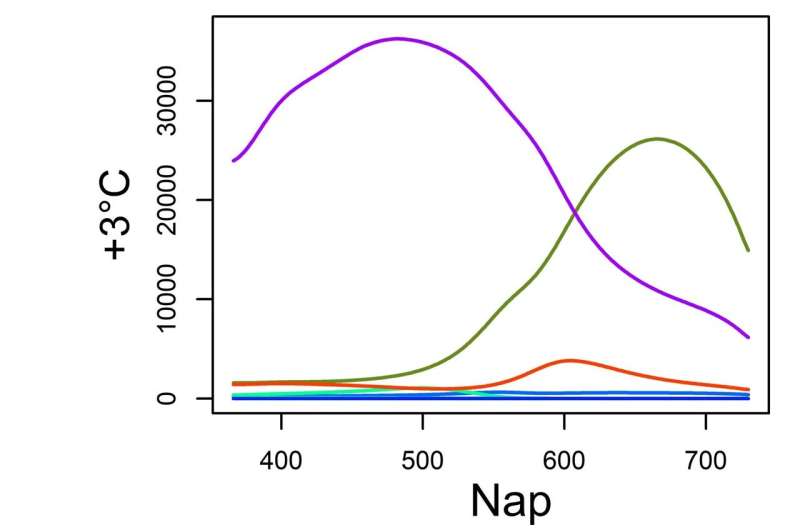This article has been reviewed according to Science X's editorial process and policies. Editors have highlighted the following attributes while ensuring the content's credibility:
fact-checked
peer-reviewed publication
proofread
Researchers develop numerical models to better understand long-term effects on lake ecosystems

Although numerous lakes around the world have been showing an increase in annual mean temperature over the last few decades, it still remains difficult to assess long-term warming-related impacts in water bodies with various physical and chemical properties and diverse communities.
Exploring these impacts is crucial not only for fish, macroinvertebrates or aquatic macrophytes, but also for planktonic organisms, which form the basis of the aquatic food web and have a substantial influence on material cycles.
Despite the broad range of sophisticated techniques developed to study this important group, elucidating how interrelated environmental factors drive plankton functioning is still a hard task due to the typically rapid dynamics of these communities.
Monitoring based on regular field work is a crucial part of research on aquatic systems, but it is also time-consuming and lab-intensive, making any sampling effort limited in both space and time. In a sense, this is like following a streaming series with several seasons by only looking at a few snapshots from each episode, trying to guess what the actual story is.
We need complementary approaches to improve our ability to assess, estimate or forecast the ecological effects of climate change. Numerical models are promising candidates for this role, gradually gaining importance in ecological research. Generally speaking, such models describe fundamental relationships in the form of mathematical equations based on current data and scientific knowledge. Such relationships include e.g. species growth as a function of food item availability or the dependence of plant photosynthetic activity on light intensity.
The strength of modeling lies in the possibility to create computer-generated simulations about changes in a population, community or ecosystem and their environment through space and/or time, helping to find causality behind natural phenomena. Thus, while field and experimental observations provide data about a series of temporary states and conditions, modeling aims at the processes that induce temporal change in those states and conditions.
In a Hungarian-Greek collaboration, Károly Pálffy researcher of the institute's Plankton Ecology Group, studied the dynamics of planktonic algae (phytoplankton, major primary producers of aquatic habitats) using an ecological modeling approach. The paper is published in the journal Limnology and Oceanography.
While analyzing a data series on Lake Balaton, Hungary in his previous study he found that the long-term rise in annual mean water temperature was accompanied by increasing seasonal fluctuations in phytoplankton composition (increasing seasonal variability), which might suggest a decline in ecosystem stability. He and his colleagues also managed to demonstrate something highly similar in a mesocosm experiment, raising the question of whether there is a more general connection between warming and the dynamics of planktonic algae.

The newly developed model made it possible to simulate changes in phytoplankton on the species level under various temperature scenarios.
The output of the simulations was in agreement with the previous observations, elevated mean temperature caused more pronounced seasonal changes in phytoplankton composition, but the degree of this impact was also highly dependent on how the communities received inorganic nutrients essential for their growth.
Accordingly, the ratio of the two most important ones, nitrogen and phosphorus as well as the temporal fluctuations in nutrient supply had significant influence on the effect of warming. This is in close agreement with recent studies that suggest the importance of considering nutrient load conditions (the so-called trophic state of a water body) when assessing the effect of climate change on aquatic ecosystems.
Besides nutrients, initial species richness of the simulated communities also affected their response to warming. From a methodological point of view, this is an important finding, since it suggests that choosing an adequate number of species can be crucial in the planning of community-scale climate change experiments.
The paper also sheds light on what long-term consequences an increase in the seasonal variability of phytoplankton can have in terms of stability.
At higher mean temperatures, seasonal extremes in community composition became more prominent, shifting the communities toward lower overall evenness.
On a longer time scale, elevated temperatures also increased the probability of species loss, providing a mathematical explanation for the role of warming in reducing plankton community stability and thus modifying aquatic ecosystem functioning. The research group has plans for further extending the model, facilitating the simulation of climate change impacts in a spatial context as well as on the level of the planktonic food web.
More information: Károly Pálffy et al, Combined effect of warming, nutrients, and species pool size on the seasonal variability of phytoplankton composition: A modeling perspective, Limnology and Oceanography (2024). DOI: 10.1002/lno.12548
Journal information: Limnology and Oceanography
Provided by Ökológiai Kutatóközpont




















